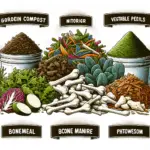Introduction
Vegetables play a crucial role in maintaining a balanced and healthy diet, providing essential nutrients like vitamins, minerals, and fiber that our bodies need to function optimally. Whether you are looking to improve your overall health, support immune function, or reduce the risk of chronic diseases, incorporating a variety of vegetables into your meals is one of the most effective and natural ways to achieve these goals.
From leafy greens like spinach and kale to root vegetables like carrots and potatoes, the benefits of eating vegetables are vast and far-reaching.
There is an impressive diversity of vegetables, each offering unique health advantages. Leafy greens, for example, are packed with vitamins A, C, and K, while root vegetables provide a rich source of carbohydrates and energy.
Cruciferous vegetables, such as broccoli and cauliflower, are known for their cancer-fighting properties, while nightshades like tomatoes and eggplants offer antioxidants that promote heart health. These different types of vegetables contribute a wide range of flavors, textures, and nutrients to our diets, making them essential components of any meal.
This guide aims to explore the different types of vegetables, their nutritional values, and tips for growing them at home. Whether you’re an avid gardener or simply want to improve your diet, understanding how to choose, prepare, and grow vegetables can help you make the most of these nutrient-rich foods. By including more vegetables in your daily meals, you can boost your health and enjoy the natural flavors and variety they offer.
As we delve deeper into the world of vegetables, you’ll find practical tips for incorporating them into your diet and even growing your own at home. This comprehensive guide will not only help you understand the benefits of different vegetables but also provide you with the knowledge to make informed choices about which ones to include in your garden and meals.
1. Understanding Vegetables
Definition of Vegetables
Vegetables are an essential category of plant-based foods that are primarily used for their nutritional and culinary benefits. In botanical terms, vegetables refer to any edible part of a plant, including leaves, roots, stems, and flowers. However, the definition of a vegetable can be flexible, as it is often determined by how a plant is used in cooking. For example, tomatoes and cucumbers are botanically fruits but are commonly classified as vegetables due to their culinary applications. This distinction between vegetables and fruits often causes confusion, but it is important to understand that the difference lies in the plant’s biological characteristics and its culinary usage.
In addition to fruits, vegetables are also distinct from herbs, which are typically used for seasoning rather than as a primary food source. While herbs such as basil, cilantro, and thyme enhance flavor, vegetables like spinach, carrots, and broccoli are consumed in larger quantities and contribute significantly to our daily intake of essential nutrients. Understanding what qualifies as a vegetable can help you make better food choices, ensuring that your diet includes a variety of nutrient-dense plant foods that support overall health.
Nutritional Value of Vegetables
Vegetables are packed with vital nutrients that are necessary for maintaining a healthy body and preventing chronic diseases. They are rich sources of vitamins such as vitamin A, which promotes healthy vision and immune function, and vitamin C, which is essential for skin health and collagen production. Additionally, vegetables provide a wealth of minerals like potassium, which helps regulate blood pressure, and magnesium, which supports muscle and nerve function. These micronutrients work together to support various bodily functions, making vegetables a key component of a balanced diet.
In addition to vitamins and minerals, vegetables are an excellent source of antioxidants, compounds that protect the body from oxidative stress and inflammation. Leafy greens like kale and spinach, for example, contain lutein and zeaxanthin, antioxidants that promote eye health, while cruciferous vegetables like broccoli and Brussels sprouts are known for their cancer-fighting properties. Fiber is another crucial nutrient found in vegetables, aiding in digestion and promoting a healthy gut. Moreover, many vegetables have high water content, contributing to hydration and overall well-being.
By including a variety of vegetables in your daily diet, you can benefit from the wide range of nutrients they offer, each playing a unique role in supporting your health.

2. Types of Vegetables
a. Leafy Greens
Leafy greens are some of the most nutrient-dense vegetables you can include in your diet. Examples of leafy greens include spinach, kale, and lettuce, each offering an array of vitamins, minerals, and antioxidants. Spinach is particularly rich in iron, which supports healthy blood circulation, while kale is loaded with vitamin K, essential for bone health and blood clotting. Lettuce, often used in salads, provides hydration due to its high water content and is low in calories, making it a great choice for those looking to maintain a balanced diet. The health benefits of leafy greens go beyond their nutritional content—they are also known to support heart health, reduce inflammation, and aid in digestion.
Incorporating leafy greens into your daily meals can improve overall health by providing essential nutrients that may be lacking in other parts of your diet. Their versatility in cooking, whether raw in salads or sautéed as side dishes, makes them easy to include in various meals.
b. Root Vegetables
Root vegetables, such as carrots, beets, and potatoes, are known for their ability to store energy in the form of carbohydrates, making them an excellent source of sustained energy. Carrots are rich in beta-carotene, which is converted to vitamin A in the body and is crucial for eye health. Beets, on the other hand, are packed with nitrates that improve blood flow and lower blood pressure, promoting cardiovascular health. Potatoes, often considered a staple food, are high in potassium and fiber, which aid in digestion and muscle function.
Though root vegetables are carbohydrate-rich, they are also packed with vital nutrients that support various aspects of health. Including these vegetables in your diet provides a steady energy source, while also offering additional health benefits from their fiber and nutrient content.
c. Cruciferous Vegetables
Cruciferous vegetables like broccoli, cauliflower, and Brussels sprouts are widely known for their cancer-fighting properties. These vegetables contain glucosinolates, sulfur-containing compounds that, when broken down in the body, produce substances that can inhibit the growth of cancer cells. Broccoli, in particular, is a powerhouse of vitamins C and K, while cauliflower is rich in fiber and supports digestive health. Brussels sprouts are loaded with antioxidants, which help protect cells from damage.
The high nutrient density and cancer-preventive qualities of cruciferous vegetables make them an essential part of a healthy diet. Regular consumption of these vegetables has been associated with a reduced risk of certain cancers, making them a valuable addition to any meal plan.
d. Nightshade Vegetables
Nightshade vegetables, such as tomatoes, peppers, and eggplants, are known for their unique nutritional profiles and wide culinary uses. Tomatoes, for example, are high in lycopene, an antioxidant that has been linked to a reduced risk of heart disease and certain types of cancer. Peppers, both sweet and hot, provide a high amount of vitamin C, boosting immune function and skin health. Eggplants are a good source of dietary fiber and phytonutrients, which contribute to overall gut health.
While nightshade vegetables are versatile in cooking and provide numerous health benefits, they are also known to contain alkaloids, compounds that can cause sensitivity in some individuals. However, for most people, these vegetables are a nutritious and delicious part of a balanced diet.
3. How to Incorporate More Vegetables into Your Diet
Tips for Meal Planning
Incorporating more vegetables into your diet starts with intentional meal planning. One of the easiest ways to ensure you’re getting enough vegetables is by adding them to each meal of the day. For breakfast, consider blending spinach or kale into smoothies or adding sautéed veggies to your scrambled eggs. For lunch, salads can be transformed by mixing in colorful vegetables like bell peppers, cucumbers, and tomatoes. At dinner, you can load up soups, stews, or stir-fries with a variety of vegetables such as zucchini, carrots, and broccoli. By planning meals with vegetables at the forefront, you not only increase your intake but also benefit from their diverse nutritional profiles.
Meal planning also allows you to prepare in advance, ensuring that you always have fresh vegetables on hand. Pre-chopping vegetables and storing them in the refrigerator makes it easier to throw them into quick meals, reducing the temptation to skip this essential food group.
Healthy Cooking Methods
The way you cook vegetables can significantly impact both their flavor and nutritional value. Some of the healthiest methods to prepare vegetables include steaming, roasting, and grilling. Steaming is an excellent method for preserving nutrients, as it minimizes water contact and short cooking times, helping retain vitamins like C and B. Roasting vegetables brings out their natural sweetness and enhances their texture, making them more enjoyable to eat. Drizzle with olive oil and season with herbs for added flavor. Grilling vegetables adds a smoky depth to their flavor while keeping them healthy with minimal added fats.
By focusing on these cooking methods, you can make vegetables the star of your meals without sacrificing taste. Whether lightly steamed or charred on the grill, properly cooked vegetables can become an exciting part of your daily diet.
Snacking on Vegetables
Vegetables aren’t just for meals; they make excellent snacks, too. Opting for vegetable-based snacks can help you meet your daily recommended intake while keeping your diet nutritious and low-calorie. Crunchy vegetables like carrots, celery, and bell peppers are perfect for dipping in healthy options like hummus, guacamole, or yogurt-based dressings. For a more creative approach, try making vegetable chips by thinly slicing root vegetables like sweet potatoes or beets, then baking them until crispy.
These snacks are satisfying and nutrient-dense, providing a healthy alternative to processed snacks. Snacking on vegetables can also help regulate your hunger throughout the day, contributing to better portion control at main meals.
4. Growing Your Own Vegetables
a. Choosing the Right Vegetables for Your Garden
When it comes to growing your own vegetables, selecting the right types for your garden is crucial for a successful harvest. Start by considering your local climate, as different vegetables thrive in specific temperature ranges and weather conditions. Cool-season vegetables like spinach, lettuce, and broccoli do well in cooler climates, while warm-season crops such as tomatoes, peppers, and cucumbers prefer hotter temperatures. Additionally, the amount of space available plays a key role in choosing vegetables. If you have a small garden or plan to grow vegetables in containers, compact plants like radishes, carrots, or leafy greens are ideal.
Another important factor is the growing season. Understanding your region’s frost dates and the length of the growing season helps you determine which vegetables can be planted at the right time to maximize yield. For beginners, it’s best to start with easy-to-grow vegetables like beans, zucchini, or lettuce that require minimal care and adapt well to different environments.
b. Basic Gardening Tips
Proper gardening techniques lay the foundation for a healthy and productive vegetable garden. Begin with soil preparation, ensuring your soil is nutrient-rich and well-draining. Adding organic matter such as compost or aged manure enhances the soil’s fertility, providing essential nutrients for your plants. After soil preparation, focus on planting techniques. Sow seeds or transplant seedlings according to the recommended spacing and depth to promote healthy root growth and prevent overcrowding.
Caring for your vegetable garden involves regular watering, especially during dry periods, but avoid overwatering as it can lead to root rot. Ensure the garden receives adequate sunlight, typically six to eight hours a day, depending on the type of vegetables. Mulching around plants helps retain moisture and suppresses weeds, creating a more favorable environment for growth.
c. Pest Management
Managing pests naturally is a critical aspect of maintaining a thriving vegetable garden. Common pests such as aphids, caterpillars, and snails can damage crops, but there are several eco-friendly solutions to keep them at bay. One effective method is introducing beneficial insects like ladybugs or lacewings that prey on harmful pests. Additionally, companion planting—growing plants that repel insects, like marigolds or garlic, next to your vegetables—can act as a natural deterrent.
For those looking for organic pest control, homemade remedies such as neem oil, diluted soap sprays, or diatomaceous earth can help combat infestations without harming beneficial organisms or the environment. Regularly inspecting your garden for signs of pests and taking prompt action will prevent small problems from escalating into larger issues, ensuring a bountiful harvest.
5. Common Vegetable Myths
a. Debunking Misconceptions
There are many myths surrounding vegetables that have persisted over time, often leading to misunderstandings about their nutritional benefits. One common myth is that “carrots improve eyesight.” While carrots are rich in beta-carotene, which is essential for eye health and can contribute to better vision, particularly in low light, they do not miraculously improve eyesight beyond what is possible through a balanced diet. Another myth is that “fresh vegetables are always better than frozen.” In reality, frozen vegetables can be just as nutritious, as they are often flash-frozen at peak ripeness, preserving their vitamins and minerals.
Similarly, the belief that “organic vegetables are significantly healthier than non-organic” can also be misleading. While organic vegetables may have lower pesticide residues, the nutritional difference between organic and conventional produce is minimal. What matters most is including a variety of vegetables in your diet, regardless of how they are grown.
b. Importance of Variety
One of the most important aspects of a healthy diet is consuming a diverse range of vegetables. Eating a variety of vegetables ensures that your body receives a wide array of vitamins, minerals, antioxidants, and fiber, each of which plays a unique role in maintaining overall health. For example, leafy greens like spinach provide high levels of iron and calcium, while brightly colored vegetables such as bell peppers and tomatoes are packed with vitamin C and beta-carotene. Root vegetables like sweet potatoes and beets offer complex carbohydrates and potassium.
Relying on just a few types of vegetables can limit your nutrient intake and may prevent you from fully benefiting from the variety of compounds found in different plant families. By diversifying your vegetable intake, you also reduce the risk of deficiencies and enjoy a broader spectrum of flavors and textures, making meals more enjoyable and nutritionally balanced.
Conclusion
In conclusion, vegetables are a cornerstone of a healthy diet, offering a wealth of nutritional benefits that are essential for maintaining good health. From debunking common myths to emphasizing the importance of variety, understanding vegetables and their role in our daily nutrition is key to reaping their full benefits. Whether you grow your own vegetables or purchase them from your local market, incorporating a wide range of types into your diet is crucial for achieving optimal health.
As you continue your journey toward better health, we encourage you to explore new vegetables, experiment with different cooking methods, and find creative ways to add more plants to your meals. Share your favorite vegetable recipes or gardening tips in the comments and inspire others to embrace the power of vegetables in their own lives.

Ultimate Guide: How to Store Harvested Produce

Mastering the Art of Vegetable Harvesting

Organic Gardening Season Texas

Easiest Vegetables to Grow in Texas: A Comprehensive Guide

Vegetables to Grow in Pots

When Should I Apply Vegetation Killer Spray? Timing Is Everything!

Can You Put Shake and Bake on Vegetables? Try This Delicious Twist Tonight!

What Happens to Salmon When Vegetation Is Removed? The Surprising Environmental Impact!

How to Use Your Senses to Pick the Freshest Vegetables – A Simple Guide!







